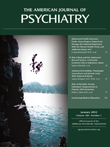Combined Treatments for Depression as for Other Medical Disorders
To the Editor: We read with great interest the article by Dr. Rush et al. on the Combining Medications to Enhance Depression Outcomes (CO-MED) study (1) and the editorial by Dr. Coryell (2) in the July 2011 issue of the Journal. The overall result of this large-scale trial is that a single antidepressant produced the same remission results as did combinations started 1 week after treatment initiation. Our main issue with CO-MED, apart from its not being a double-blind study, is the dosing of the antidepressants. The CO-MED study did not adhere to an important rule of combination treatment in medicine: use similar and/or effective dosages of both agents. For instance, when treating asthma, physicians should administer standard doses of both a β2-adrenergic agonist and an inhaled steroid, not lower doses. Physicians were aware of the dosages used throughout the study, and despite the use of a decision tree involving tolerability and response for titration, the dose of escitalopram was near the maximum in the monotherapy arm and was significantly lower when combined with bupropion. Consequently, the dosage issue has not been “credibly dismissed” in the CO-MED study (2).
One possible explanation for the identical remission rates in the venlafaxine-mirtazapine arm and the escitalopram arm is that the combination arm was again underdosed. Several studies supporting the superiority of this combination consistently used higher dosages. The mean of the daily doses of mirtazapine was only 20 mg in the CO-MED study, which is below its minimal effective daily dose of 30 mg. The mean of the daily doses of venlafaxine was 192 mg, which is below its noradrenergic range of 225 mg/day (3). Rush et al. (1) point out that no difference in remission rates was observed between the 86 patients who reached the daily regimen of 225 mg of venlafaxine and 30 mg of mirtazapine and those who were in the escitalopram arm. However, the authors indicate that this regimen was achieved “at any time during treatment.” It is unclear how long these dosages were maintained. In two double-blind studies (4, 5), we doubled the remission rates using adequately dosed combinations of mirtazapine and other antidepressants, and the dropout rates were below 15%; no patients in the fixed venlafaxine (225 mg) and mirtazapine (30 mg) group dropped out because of side effects. The double-blind structure of our studies likely contributed to patients tolerating side effects because neither they nor the investigators knew if a dosage titration was used. On the one hand, the CO-MED study results may reflect the underdosing that can happen in a community sample. On the other hand, this approach limits our ability to validate the superiority of the venlafaxine-mirtazapine combination because most patients were on a dosage of venlafaxine that did not inhibit norepinephrine reuptake and a sedative/non-antidepressant dosage of mirtazapine during the trial.
More studies on combining antidepressant drugs from treatment initiation are needed, especially those that keep in mind the above-mentioned pitfalls. Nevertheless, a crucial take-home message from the CO-MED study is that if patients are treated with a combination of antidepressants, they should be receiving adequate dosages because a single medication may do just as well.
1. : Combining Medications to Enhance Depression Outcomes (CO-MED): acute and long-term outcomes of a single-blind randomized study. Am J Psychiatry 2011; 168:689–701Link, Google Scholar
2. : The search for improved antidepressant strategies: is bigger better? Am J Psychiatry 2011; 168:664–666Link, Google Scholar
3. : Differential physiological effects of a low dose and high doses of venlafaxine in major depression. Int J Neuropsychopharmacol 2007; 10:51–61Crossref, Medline, Google Scholar
4. : Mirtazapine and paroxetine in major depression: a comparison of monotherapy versus their combination from treatment initiation. Eur Neuropsychopharmacol 2009; 19:457–465Crossref, Medline, Google Scholar
5. : Combination of antidepressant medications from treatment initiation for major depressive disorder: a double-blind randomized study. Am J Psychiatry 2010; 167:281–288Link, Google Scholar



